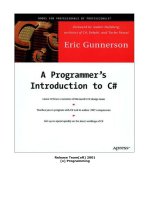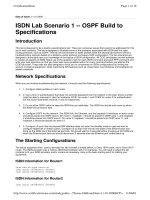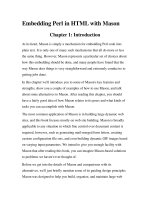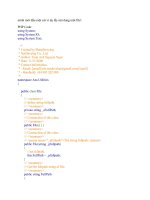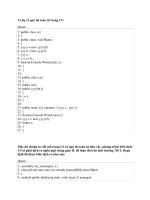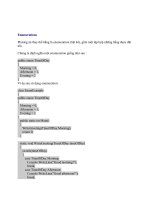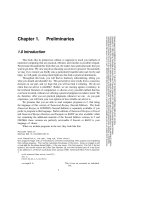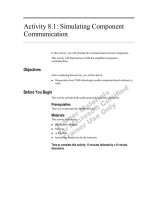Tài liệu C++ Lab 1 Introduction pdf
Bạn đang xem bản rút gọn của tài liệu. Xem và tải ngay bản đầy đủ của tài liệu tại đây (215 KB, 12 trang )
C++
Lab 1
Introduction
Required terminology and general information for this chapter:
Program – a series of instructions for a computer to execute.
Programming languages: Machine, Assembly, and High Level
How the first computers were programmed? By manually connecting wires.
Machine language: programs and data were entered into the
computer using zeros and ones. All operation codes (opcodes) and
operands were entered in binary numbers. Machine language is
the machine "understandable" language. It does not matter what
other languages are used to program, eventually all programs and
data will have to be translated into a "machine executable" format.
Assembly Language: An easier programming language than
machine language, where programs are written using familiar
symbols (for example A for add). The operands could be in
binary, hexadecimal or decimal format. For every machine
language code, there needs to be one assembly language code.
The program was not shorter, just easier to write. Once the
program was written in assembly language, it had to be compiled
to produce the machine executable code in order to run the
program. The compiler used is called an ASSEMBLER.
High Level Language: Included are languages such as Fortran
(Formula Translator), COBOL (Common Business Oriented
Language), BASIC (Beginner’s All purpose Symbolic Instruction
Code), Pascal, C, Ada, and many more. Programs are much
shorter than lower level languages. Each instruction is converted
to several machine executable codes. This conversion is done in
three steps: preprocessing, compiling and linking. An original
program written using an EDITOR in a high level language is
known as the Source Code. A compiled program is called the
Object Code and the linked program is called the Executable
Code. Examples of files created in each stage are: Carpet.CPP,
Carpet.OBJ, and Carpet.EXE
Syntax: Rules for constructing a legal sentence in a programming
language. If a program has syntax errors, it will not compile.
Therefore, it produces compile time errors.
Semantics: Rules that determine the meaning of instructions
written in a programming language.
Runtime and Logical errors: A runtime error occurs when the
program cannot execute what is being asked to do. For example,
open a file when it does not exist. Logical errors are most difficult
to fix; it is caused by faulty logic by the programmer. For
example, suppose you wanted write a program to give discount if
purchase is greater than $100.00, instead you programmed to give
discount if purchase is less than $100.00.
C++: The C (Dennis Ritchie) language is a modification of
another language called BCPL (Ken Thompson). C language was
written for programming under the Unix operating system
environment which continues to be a very popular operating
system for universities and businesses. C++ (Bjarne Stroustrup) is
an object oriented version of C.
Constant : a data item that does not change during the execution
of the program. A constant could be a named constant or a literal
constant. Example of a literal constant is given in the following
program. Example of a named constant is:
const float TAX_RATE = 8.025; //TAX_RATE is a
named constant // 8.025 is a literal
constant
First C++ program: Call up the C++ programming environment from your
windows desktop and type the following program in. Compile, and run it.
If you do not know how to write the source code and compile, go to the end of
this chapter where I explain it in the appendix.
Program 1-1
/********************************
Say Hello program
By Dr. John Abraham
Created for 1380 students
Teaching objective: program structure
********************************/
#include <iostream> //this is preprocessor directive
using namespace std; //tells the compiler certain objects such as cout are
contained in the standard namespace
int main () //this is the main function
{
cout << "See mom! I wrote my first C++ program\n";
getchar(); //wait for the enter key to be pressed. Try the program without this
line.
return 0;
}
Program run 1
See mom! I wrote my first C++ program
Save your program to your floppy or thumb drive by clicking File, Save
Hello.cpp as (the name will be whatever you named it. I named it Hello),
and give it a name like a:assignment1.cpp.
A program in C++ is a collection of one or more functions. This program has
only one function named main. The function main is a required function in all
programs. If there are several functions in a program, each function carries out
a different task. The main function will call other functions into action.
Description of the program: Lines beginning with /* and ending with */ are
comments, C++ ignores these lines. These comments are used for internal
documentation. // may be used for commenting one line.
Preprocessor library: C language is a small language and does not have
inherent input/output support. Input/output support is provided by modules
(library). This program outputs one line of text to the monitor. The monitor is
the standard output device and the keyboard is the standard input device. A
pound sign # indicates that the remainder of that line is an instruction
(directive) to the compiler. #include <iostream.h> tells the compiler to add the
code found in that file to the beginning of this program. This code handles all
character stream inputs and outputs. Without this you cannot read from the
keyboard or display anything to the monitor.
A function: int main () is a function. A function receives one or more
parameters (arguments) from the calling module and returns none or one result
to the calling module. The word int before the function name (main) indicates
that the function will return an integer to the calling module. The calling
module of the main is the operating system. This program returns a zero to the
operating system, indicating normal execution. The () after the function name
indicates that this function does not receive any parameters from the calling
module. Later we will see variations to this.
Begin and End of a block: The beginning of a body or compound statement is
indicated by { and the ending is indicated by }.
Statement separator: A statement is separated from another statement by
placing a semicolon between them. End of the line does not indicate end of a
statement.
cout and cin: cout displays (prints) to an output device such as a monitor, and
cin receives input from an input device such as a keyboard. The << or >>
indicates the direction of flow of the data. In this program, "See mom! I
wrote my first C++ program\n, is the data (in this case the data is
a literal) that flows into the output device. Notice that the string literal is
enclosed in double quotes. The last two characters in the literal \n makes the
cursor to go to a new line. The backslash is used as a symbol for escape. An
escape sequence is used to control output devices. We will see additional
escape sequences later.
The return statement: return 0, returns zero to the calling module through the
main. In this case, the operating system is given the value 0, indicating that the
program had a normal execution. Perhaps, another procedure would have
returned a result of a calculation to the calling module.
Program 1-1A
/********************************
Say Hello program
By Dr. John Abraham
Created for 1380 students
********************************/
#include <iostream> //this is preprocessor directive
using namespace std.
int main () //this is the main function
{
cout << "See mom! I wrote my first C++ program\n";
getchar(); //wait for the enter key to be pressed
return 0;
}
Arithmetic in C++
When we write code in C++ to do calculations, it is important to
remember that results of integer and integer calculations may be different than
real and real calculations. We also need to know how mixed number
calculations will be carried out. C++ will allow you to assign a number with
decimal to an integer, however, the fractional part will be discarded. Program
1-2 explores various arithmetic calculations.
Program 1-2
/*****************************************
c++ Arithmetic
By Dr. John Abraham
Created for 1380 students
Instructional objective: Arithmetic
******************************************/
#include <iostream> //this is preprocessor directive
using namespace std; //using directive
int main () //this is the main function
{
int i,j,k,l, m,n;
float a,b,c;
//integer operations
cout << "INTEGER OPERATIONS\n \n";
i = 6 + 3;
l = 6.5;
m = 3.5;
j = l + m;
k = 10 /3;
n = 10 % 3;
cout << "6 + 3 = " << i << "\n";
cout << "l = 6.5, m = 3.5 >l + m = " << j << "\n";
cout << "10 / 3 = " << k << "\n";
cout << "10 % 3 = " << n << "\n";
//real and mixed operations
cout << "\nREAL AND MIXED OPERATIONS \n \n";
a = 10 / 3;
b = 10.0 / 3.0;
c = 10.0 /3;
cout << "10 / 3 = " << a << "\n";
cout << "10.0 / 3.0 = " << b << "\n";
cout << "10.0 / 3 = " << c << "\n";
getchar();
return 0;
}
INTEGER OPERATIONS
6 + 3 = 9
l = 6.5, m = 3.5 >l + m = 9
10 / 3 = 3
10 % 3 = 1
REAL AND MIXED OPERATIONS
10 / 3 = 3
10.0 / 3.0 = 3.33333
10.0 / 3 = 3.33333
If l=6.5 and m =3.5 then l+m should be 10, why is it 9? We assigned these
numbers to integer variables, which discards the fractional part leaving 6 and 3,
which give a total of 9. How about 10/9 yielding 3? This is called integer
division. The next problem 10 % 3 gives a result of 1, which is the remainder of
the integer division (also known as the modulus). In the next problem even
though we assigned the result of 10/3 to a real variable (a), the variable only
received the result of an integer division. The result of 10.0/3.0 is 3.333333;
here both numbers are real numbers (float). However the last problem 10.0/3
also gives 3.33333, why? In a mixed operation like this the integer is converted
to float first, then the operation is carried out.
Homework
The terminology given at the beginning of this chapter is very important. You
must learn it thoroughly. Make q-cards and memorize the terms.
Write this program over and over again until you do not have to look at the
notes. You should not continue to the next chapter until you mastered this
chapter thoroughly.
This homework may appear surprisingly easy to you. Don’t be fooled. Many
students do not finish the course because they do not spend much time with the
first two chapters.
Write a program to determine the number of thousands, hundreds, tens, and
ones in a given number. Hint: use integer division and modulus. Example of a
program run:
In 8532 there are
8 thousands
5 hundreds
3 tens
2 ones.
Appendix
How to launch Microsoft visual studio, write a program, compile and run.
1. Find the icon for Microsoft visual studio 2005 and click it to launch the
program.
2. The start page looks like this:
3. You will see Open and Create. Click on Create Project. On the left side
you will see the languages, if C++ is not shown click on other languages.
Click on Visual C++ and Win 32 console application. Enter a name
such as Hello Program. Pay attention to the location and subdirectory.
This is where all your programs will be kept.
4. Click OK, then click next. In the following screen click empty project
and press finish.
5. This step is important: right click on source files in the solution
explorer and click to add new item. If the solution explorer does not
show up you need to click on the solution explorer icon (the one with the
magnifying lens).
6. Click on code on the left side and click on C++ file. Give it a name and
click Add.
7. Type in the program.
